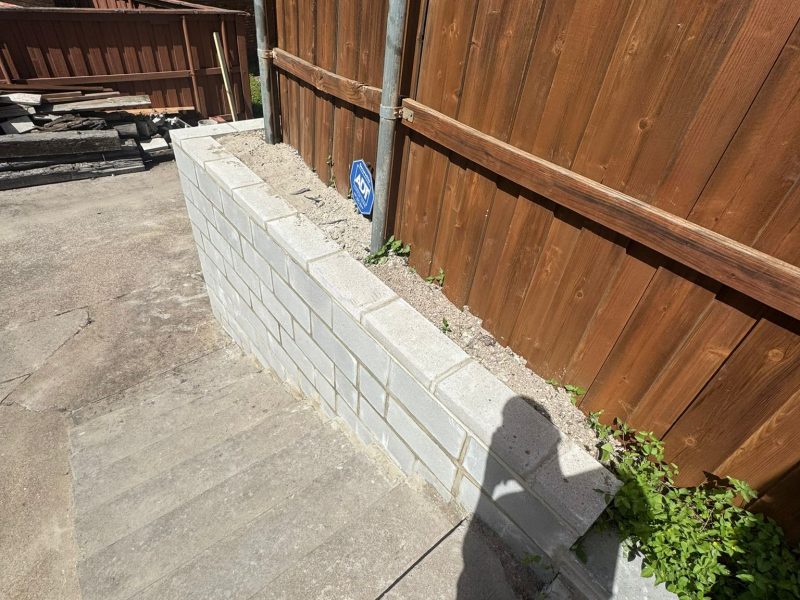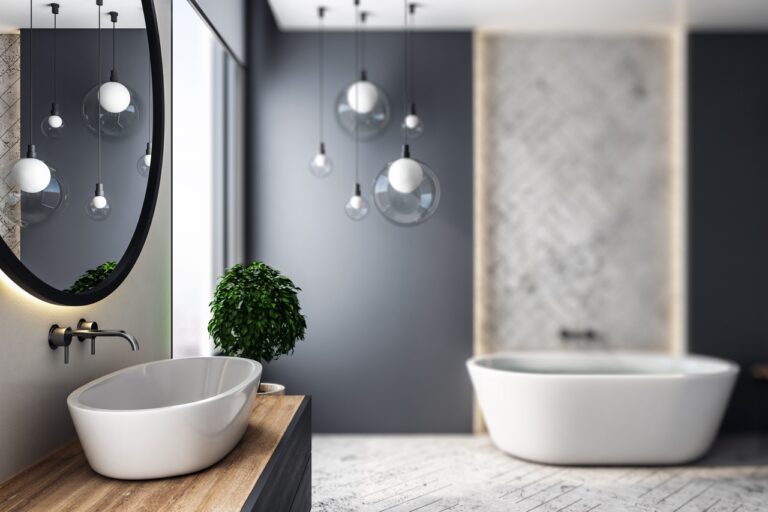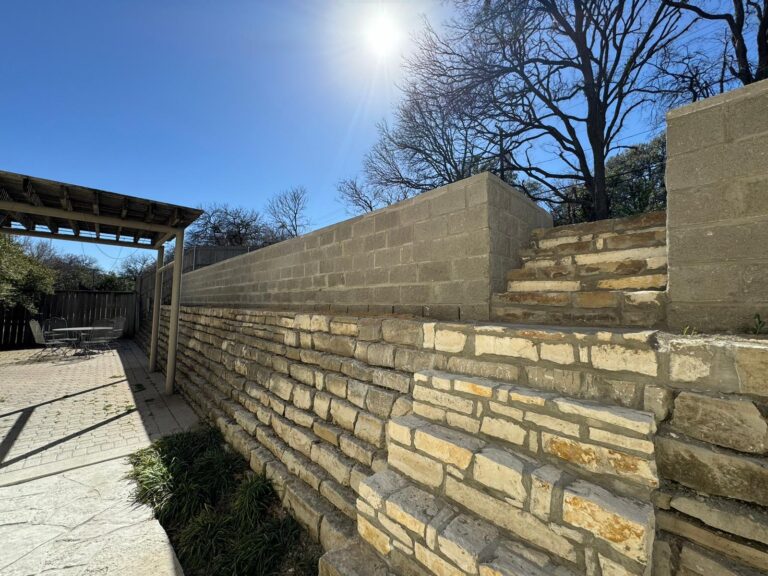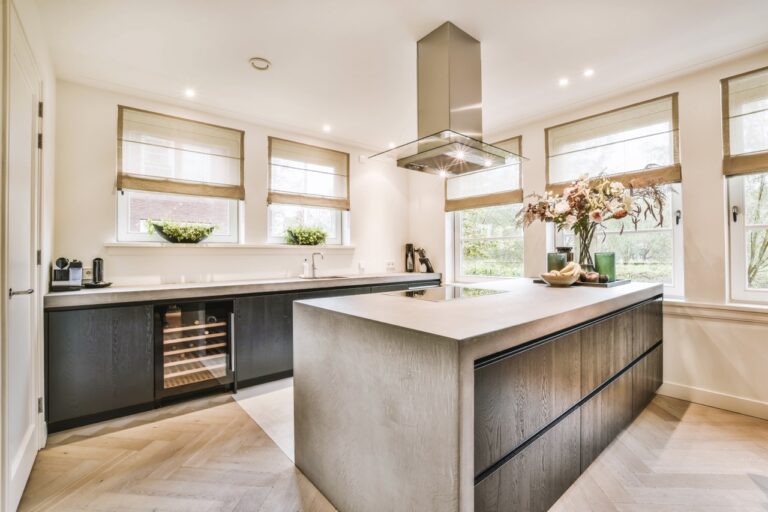Retaining walls are vital to keeping your landscape stable, safe, and attractive. But over time, even the most well-built wall can show signs of damage, cracking, bulging, or leaning.Where soil shifts and heavy rain are common, the need for reliable retaining wall repair and replacement has never been greater.
Whether your wall supports a garden, driveway, or slope, professional service ensures it continues to protect your property while maintaining visual appeal. The best retaining wall repair experts in Arlington TX combine engineering precision with local knowledge to restore both strength and beauty to your outdoor space.
In this guide, we’ll explore the causes of wall failure, repair options, material choices, and how to choose the right professionals for lasting results.
1. Common Signs Your Retaining Wall Needs Attention
Retaining walls don’t fail overnight, they often give early warnings. Recognizing these signs early helps prevent costly damage and safety hazards.
Watch for These Warning Signs:
- Noticeable cracks or gaps in bricks or concrete
- Bulging, leaning, or tilting sections of the wall
- Soil erosion or pooling water behind the wall
- Separated joints or crumbling mortar
- Drainage water seeping through unexpected areas
These issues can weaken structural integrity and put your property at risk. Regular inspections and prompt maintenance are key to avoiding full replacements.
2. Why Retaining Walls Fail
Understanding what causes wall damage helps in choosing the right repair method. Arlington’s varied weather, from heavy rains to dry heat, puts constant stress on outdoor structures.
The most common causes include:
- Poor drainage: Water buildup behind walls creates pressure and leads to cracking.
- Improper backfill materials: Lightweight soil or organic fill can compress and destabilize foundations.
- Insufficient reinforcement: Missing rebar or weak foundations cause leaning or collapse.
- Tree roots: Expanding roots can push against the wall’s structure.
- Age and natural wear: Materials degrade over time, especially in high-moisture conditions.
To learn more about preventive wall care, you can review maintenance tips here from local Arlington retaining wall specialists.
3. Assessing the Damage: Repair or Replace?
Not all wall damage requires full reconstruction. A professional assessment determines whether a repair or total replacement is best for your situation.
When Repair Is Enough:
- Minor cracks or slight leaning
- Small sections of wall failure
- Surface wear without foundational issues
- Minor drainage or erosion problems
When Replacement Is Necessary:
- Extensive structural cracking
- Major bulging or leaning
- Repeated drainage failures
- Old materials that have lost integrity
Repair extends lifespan when the foundation remains stable, while replacement ensures long-term performance when damage is severe.
4. Professional Retaining Wall Repair Methods
Expert contractors use specialized techniques and materials to restore wall stability and function effectively.
Top Repair Techniques in Arlington TX:
- Crack Injection: Seals small to medium cracks using epoxy or polyurethane.
- Tieback Reinforcement: Adds steel rods or anchors to strengthen leaning walls.
- Drainage Upgrades: Improves water flow using perforated pipes and gravel backfill.
- Surface Restoration: Repairs chipped or weathered finishes for aesthetic improvement.
- Repointing: Replaces damaged mortar joints in brick or stone walls.
For homeowners unsure which solution fits their needs, you can find professional guidance here from trusted retaining wall repair experts.
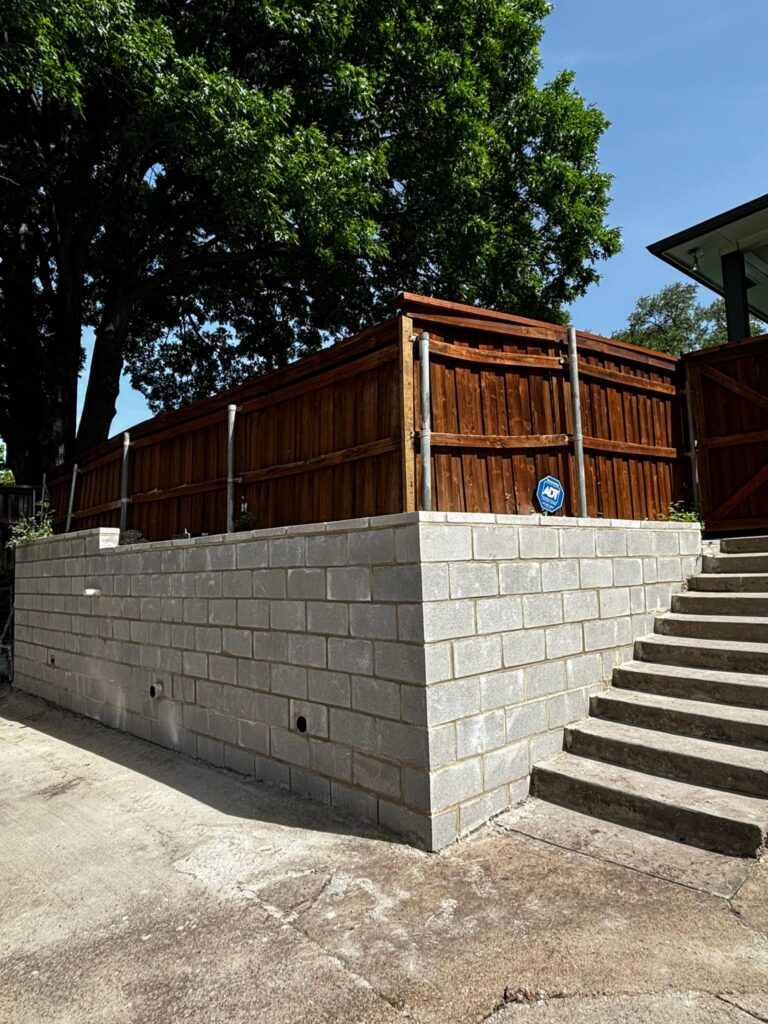
5. Replacement: Building a Stronger, Longer-Lasting Wall
When repairs can’t guarantee durability, replacement becomes the smarter investment. A professionally rebuilt wall corrects prior design flaws and incorporates modern engineering for added longevity.
Contractors evaluate slope, soil density, and drainage before rebuilding. They may use geogrid reinforcement, deeper footings, and improved water diversion systems to ensure lasting strength.
Replacing an old wall also gives you an opportunity to upgrade its style, choosing new materials, colors, and layouts that complement your landscape perfectly.
6. Choosing the Right Material for Your Retaining Wall
Material selection affects both aesthetics and performance.Climate requires durable, moisture-resistant materials that balance cost, appearance, and longevity.
Best Materials for Retaining Wall Repair and Replacement:
- Concrete Blocks: Economical, strong, and available in many styles
- Natural Stone: Elegant with natural variation and high durability
- Brick: Classic look with long-lasting stability
- Timber: Rustic charm but best for short-term or decorative walls
- Interlocking Systems: Offer quick installation with excellent drainage
Pro Tip: Match your wall’s material with your home’s exterior for seamless design. You can see more design options here to find the perfect balance between beauty and functionality.
7. The Importance of Drainage in Wall Stability
Without proper drainage, even the strongest wall can fail. Hydrostatic pressure builds up behind walls during heavy rainfall, pushing against the structure.
Professionals install perforated drain pipes, gravel backfill, and weep holes to prevent water accumulation. Some advanced systems even include geo-fabric barriers that filter debris while allowing water to pass through.
Effective drainage ensures your wall remains upright and crack-free for years. For more insight into drainage design, you can explore technical advice here from local retaining wall builders.
8. Benefits of Professional Repair Services
DIY might seem tempting, but retaining wall repair requires engineering precision. Experienced professionals bring tools, training, and techniques that guarantee lasting solutions.
Benefits of Hiring Professionals:
- Accurate problem diagnosis
- Proper use of structural reinforcements
- Quality materials suited for local conditions
- Compliance with city permits and codes
- Long-term warranties on workmanship
Professional expertise ensures your investment delivers both safety and style.
9. Enhancing Curb Appeal Through Wall Restoration
Beyond function, a well-restored retaining wall boosts curb appeal and property value. Homeowners in Arlington increasingly use repair or replacement as part of full landscape makeovers.
Fresh materials, smooth finishes, and coordinated landscaping can make your yard look modern and well-maintained. Strategic lighting or decorative stone textures also turn your retaining wall into a design feature, not just a barrier.
To find creative inspiration for enhancing your property’s look, you can browse outdoor renovation ideas here from design specialists.
10. Preventing Future Damage
After your wall is repaired or rebuilt, routine maintenance keeps it in prime condition for decades.
Simple Maintenance Steps:
- Inspect walls every six months for cracks or movement
- Clear drainage outlets regularly
- Trim nearby roots to prevent pressure damage
- Reseal porous materials as needed
- Maintain consistent soil grading behind the wall
These habits prevent recurring issues and protect your long-term investment.
11. Factors Affecting Cost and Timeline
Project costs depend on materials, design complexity, and damage severity.
On average, retaining wall repair in Arlington TX ranges between $1,500 and $5,000 for moderate issues, while replacements can reach $7,000–$15,000 depending on wall size.
Key Factors That Influence Pricing:
- Wall height and length
- Material selection
- Drainage requirements
- Accessibility of the work area
- Labor and engineering costs
Always request multiple quotes from licensed local contractors before starting your project.
12. Why Local Experience Matters
Choosing a local retaining wall company ensures your project benefits from professionals who understand regional soil types, drainage patterns, and city regulations.
Local contractors are easier to reach, provide faster responses, and often offer long-term maintenance support. They also have relationships with local suppliers, reducing delays and ensuring cost-effective material sourcing.
To find qualified professionals near you, you can learn more about reputable Arlington retaining wall specialists here for expert assistance.
Conclusion
Strong, durable retaining walls are essential for property safety and curb appeal. When cracks, tilting, or erosion appear, timely retaining wall repair and replacement restore both structure and style.
By partnering with skilled local professionals, you ensure the wall is built or repaired with precision, proper drainage, and lasting craftsmanship.
For trusted expertise, Modern Build Solutions offers high-quality retaining wall repair and replacement in Arlington TX backed by experience, transparent communication, and long-term results. You can also connect with their Arlington team or explore their service areas to plan your next outdoor upgrade.
Frequently Asked Questions
1. How do I know if my retaining wall needs repair or replacement?
Cracks, bulging, or leaning are early signs. A professional inspection determines the right solution.
2. What causes retaining walls to lean or crack?
Poor drainage, soil movement, and weak foundations are the most common causes.
3. Can damaged retaining walls be repaired without full replacement?
Yes, if the foundation is stable. Minor cracks or partial failures can often be repaired.
4. How long does retaining wall repair take?
Most repairs are completed within three to seven days depending on scope.
5. Do I need a permit for wall repair or replacement?
Yes, walls over four feet typically require city permits. Local contractors handle this.
6. What’s the best material for replacing a retaining wall?
Concrete blocks and natural stone are durable choices for Texas weather.
7. How can I prevent future wall damage?
Maintain good drainage, inspect regularly, and trim nearby vegetation.
8. Can I install drainage myself?
It’s best handled by professionals to ensure correct slope and water management.
9. How much does retaining wall replacement cost?
Average replacements range between $7,000 and $15,000 depending on material and design.
10. How do I choose the right retaining wall contractor?
Look for licensed, insured professionals with local experience and strong reviews.

